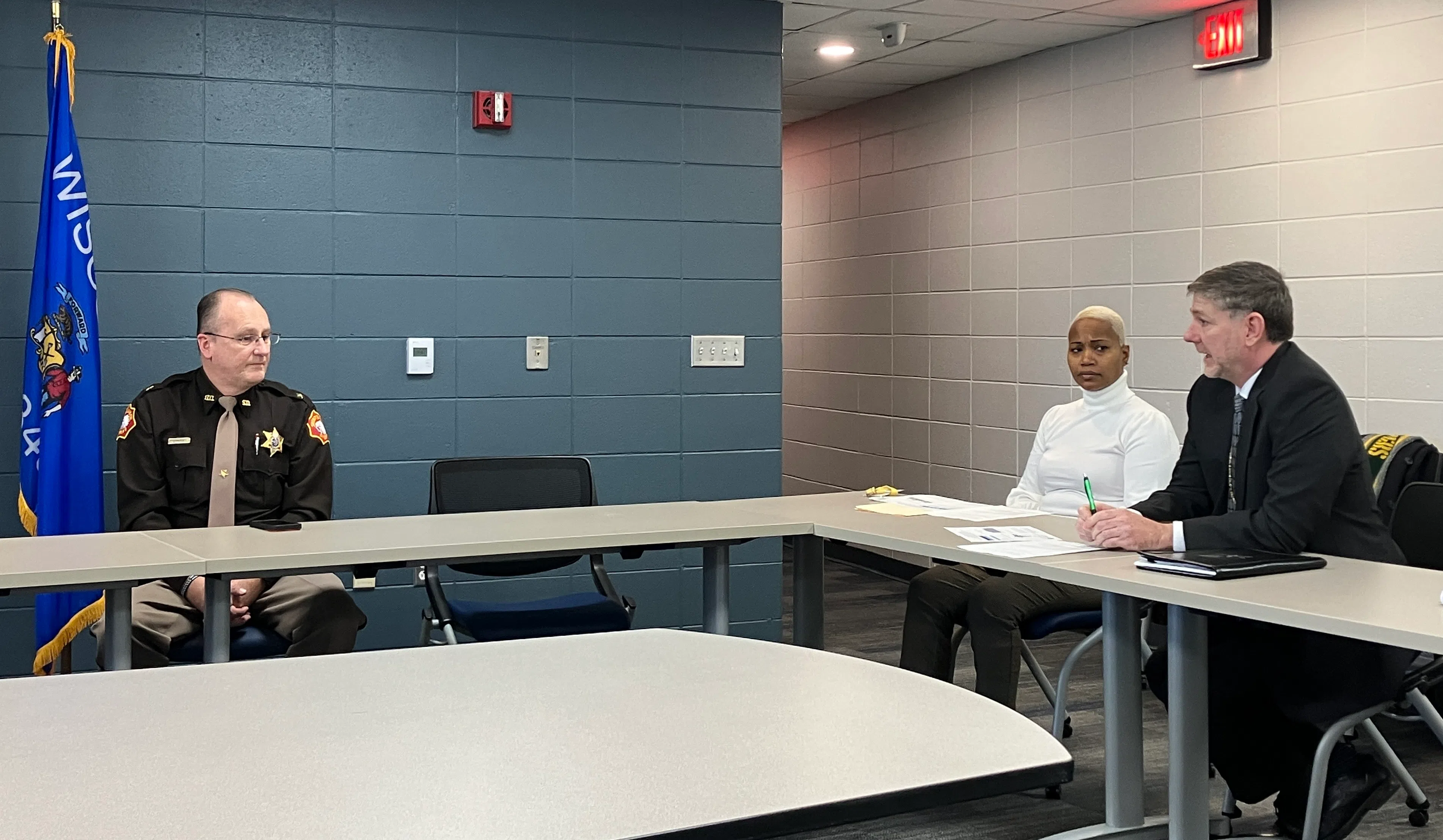A meeting of the minds of sorts took place this past Saturday at the very facility in which Sheboygan County’s opioid problem becomes most apparent – the Sheboygan County Detention Center. The goal: to collect input that can be used to figure out how best to apply millions of dollars awarded to public safety agencies from the settlement of a federal lawsuit against opioid manufacturers.
Wisconsin Senator Tammy Baldwin met with Sheboygan County Sheriff Cory Roeseler, Sheboygan County Jail Administrator Patrick Bricco, Sheboygan County Administrator Alayne Krause, Curt Brauer – the Sheboygan County Board Supervisor who chairs the Health and Human Services Committee, Jatonn Gee – the Sheboygan County Corrections Crisis Case Manager, Captain Matt Spence of the Sheboygan County Sheriff’s Office, and Matt Strittmatter, the Director of Health and Human Services for Sheboygan County.
All were there to talk about the “Safe Response Act”, co-authored by Democrat Senator Baldwin along with Republican Shelley Moore Capito of West Virginia and Democrat Maggie Hassan of New Hampshire. If passed, the Safe Response Act would reauthorize a grant program included as part of the bipartisan SUPPORT Act, which was signed into law in 2018, and would provide $57 million per year for fiscal years 2024 through 2028 for grants to states, local government entities, and Tribes.
The conditions of the grant, though are very specific in that they can only be used to ensure training of first responders and EMS personnel in utilizing overdose reversal devices and medications; provide technical assistance and training in order to prevent or treat accidental exposure to powerful opioid drugs; to establish processes, protocols, and mechanisms for referral to appropriate treatment such as through an outreach coordinator; and to educate first responders and other key community members on safe operating procedures when potentially exposed to fentanyl, carfentanil, and other dangerous drugs, whether legal or not.
The Sheboygan County Detention Center can hold up to 320 individuals, and population numbers are now approaching pre-pandemic levels near that limit. The numbers are maintained with releases offset by around 300 bookings per month. Some of those will stay a few days, while others will be there for months or longer. But of those 300 monthly bookings, Jail Administrator Patrick Bricco said that around 40% could be considered involved in some way with opioids. Those who stay longer can get into programs within the institution to help them get off the addictive drugs. Those released earlier may not have such programs or support available to them.

Sheboygan County Sheriff Cory Roeseler (L) Discusses Use of Safe Response Act Funds with Jatonn Gee and Matt Strittmatter during Saturday’s Roundtable Discussion with US Senator Tammy Baldwin. Photo by Kevin Zimmermann
One-by-one, attendees at Saturday’s meeting related the efforts being made to give the individuals involved within the County system a better chance of escaping the clutches of addiction. Those individuals consist of 300 now housed at the Detention Center, and another 500 out on supervised release through the alternatives to incarceration program.
Sheriff Roeseler related to Senator Baldwin that everyone coming into the Detention Center is ideally entering a drug-free environment, but still addiction does not stop. Instead, it sleeps, threatening to re-awake unless intervention is available to keep it at bay. Those on supervised release are at an increased risk of relapsing into addiction patterns as they live within the general population. One program to help break the addictions is available to those who voluntarily accept the drug Vivitrol, which takes away cravings. Funded through a grant by the County Department of Health and Human Services, Vivitrol is administered every 4 weeks for 11 months. The program is very successful according to the Sheriff, but it’s entirely voluntary. Roeseler related that maintaining the Vivitrol program is one good way to apply the grant money, but he also said that the program alone can’t substitute for what he called the “warm handshake” of one-on-one human interaction. The person now doing that interaction is Jatonn Gee, who was hired last year as the Crisis Case Manager for Sheboygan County Corrections.
Gee said that her job involves “a lot of moving parts.” She takes an “old-school” approach that involves direct, one-on-one contact, especially with those who will soon be released from incarceration. It’s Gee’s job to make sure those individuals have housing and insurance, ongoing addiction support if needed, and mental health counseling – something most recovering addicts will need. But that presents another problem: the ongoing shortage of mental health professionals.
That shortage affects the private sector as well, but for those reentering society, that shortage hits hardest at a critical point in time…heading back into the world without the day-to-day attention that was given as a ward of the County. Gee said that she can sign up an individual to get counseling, but also has to tell them that they can expect to wait weeks, or even months, before getting an appointment. She said that in the interim – and after counseling begins, she does her best to maintain regular contact with each of the 800 individuals she takes care of. But there was unanimous agreement that such a case load can’t be sustained by just one person, and that more help is needed – another potential use for Safe Response Act money.
Other areas where the grant could be spent include making sure all EMS and public protection personnel have the training and overdose-reversal drugs, such as NARCAN, to address overdose cases they need to handle, as well as for their own protection. Sheriff Roeseler related that there has been at least one instance in which a corrections personnel processing an incoming resident contacted a substance during booking and suffered symptoms that required NARCAN and hospitalization for recovery. Ensuring that training and supplies are available is another application of Safe Response Act money that Senator Baldwin will take into account while crafting details of her proposal.
After an hour of Q&A, bouncing ideas back-and-forth, the roundtable broke up. But ideas kept flowing between many of those involved. All agreed that there are many, many ways that the Safe Response Act grant can be applied. And all seemed hopeful that the bill will pass, making their mission a little easier to accomplish. As Administrator Strittmatter put it, that mission includes harm reduction first. But that’s not the prime goal; that goal is to get everyone who’s released from the Detention Center past addiction and on to better things.






Comments